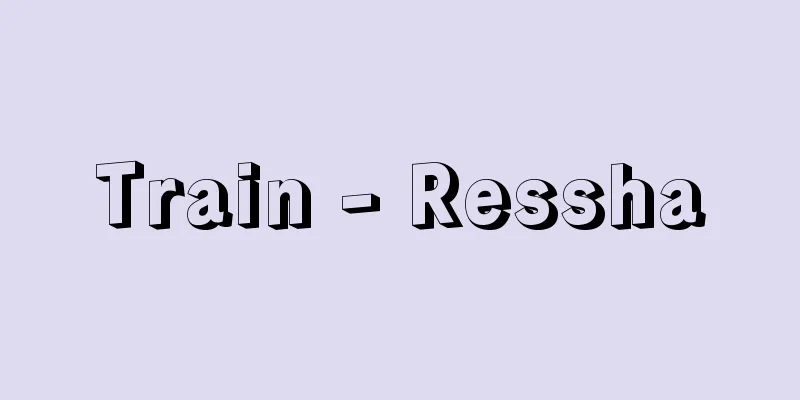Train - Ressha

|
A train is a set of rolling stock arranged for the purpose of operating on tracks outside of stations. There are several conditions that trains must meet, primarily for safety reasons. These include traction constant, braking distance, braking axle ratio, train length, etc., being within standards, and maximum permitted speed. Trains are classified into passenger trains, baggage trains, mixed trains, special trains, freight trains, and single-car locomotive trains based on their purpose. Passenger trains are further classified into special express, regular express, and regular trains, and freight trains are classified into high-speed freight, direct freight, rapid freight, special freight, regular freight, and uncoupled freight, and the maximum speeds of trains naturally differ depending on their characteristics. Special trains include imperial trains, test run trains, construction trains, and snow removal trains. Trains are also classified into regular trains and irregular (seasonal, special) trains based on the period of operation, and there are three types of trains based on the power source: electric trains, diesel multi-car trains, and locomotive (electric, diesel, steam)-pulled trains. Based on the mode of use, trains can also be classified into daytime, nighttime, long-distance, medium-distance, short-distance, commuting, school, and leisure. [Hiroshi Tsuchida] Train NumberTrain numbers are like the name of the train, and all trains are assigned numbers that give an idea of the train's characteristics (except for imperial trains and special trains for the emperor's use, which are not assigned numbers). The JR Group has established a standard for assigning train numbers. According to this, train numbers are made up of one to four digits, with M at the end for electric trains and D for diesel trains. The Tokaido and Sanyo Shinkansen use A, the Tohoku and Joetsu Shinkansen use B and C, respectively, and some former national railways on commuter lines use H, K, S, T, etc. As a rule, even numbers are assigned to inbound trains and odd numbers to outbound trains. Additionally, passenger trains use numbers between 0 and 49, and freight trains use numbers between 50 and 99 (there are exceptions in the former national railway sections). Additionally, numbers in the thousands are used to indicate line sections, routes, seasons, and special trains (6 and 7 in the thousandth place are seasonal, 8 and 9 are special, etc.). Train numbers are very important in terms of transportation management, so they are set up so that trains with the same number never arrive or depart from the same station. [Hiroshi Tsuchida] [Reference] | | | | |Source: Shogakukan Encyclopedia Nipponica About Encyclopedia Nipponica Information | Legend |
|
鉄道において停車場外の線路を運転させる目的で組成された一連の車両のこと。主として安全性確保の面から、列車が満たすべき条件がいくつか定められている。牽引(けんいん)定数、ブレーキ距離、ブレーキ軸割合、列車長などが基準内であること、許される最高速度などがそれである。 列車は、その目的から旅客列車、荷物列車、混合列車、特殊列車、貨物列車、単行機関車列車に分類される。旅客列車は、さらに特別急行、普通急行、普通列車に、また貨物列車は、高速貨物、直行貨物、快速貨物、専用貨物、普通貨物、解結貨物に分類され、最高速度も、その性格によっておのずと異なったものとなっている。特殊列車には、お召列車、試運転列車、工事列車、排雪列車などが含まれる。また列車は、運転期間により定期列車と不定期(季節、臨時)列車とに分類され、動力方式の面で分類すると、電車列車、ディーゼル動車列車、機関車(電気、ディーゼル、蒸気)牽引列車の3種類がある。利用の形態からみれば、昼行、夜行、長距離、中距離、短距離、通勤、通学、行楽などに分けることもできる。 [土田 廣] 列車番号列車番号はその列車の名前ともいうべきもので、すべての列車には番号が付され、それによってその列車のおおよその性格を知ることができる(ただし、お召列車と御乗用臨時列車には列車番号をつけないことになっている)。JRグループでは列車番号の付け方の標準を定めている。これによると、列車番号には1~4桁(けた)の数字を用い、その末尾に電車列車ならばM、ディーゼル動車列車ならばDを付す。東海道・山陽新幹線ではA、東北、上越新幹線ではそれぞれB、C、また通勤線区の旧国電にはH、K、S、Tなどを用いているところもある。上り列車には偶数、下り列車には奇数の列車番号を割り当てるのが原則である。 また旅客列車には10位以下の数字が0~49、貨物列車には10位以下の数字が50~99の数字を用いる(旧国電区間では例外もある)。そのほか、線区、系統、季節、臨時の区別を表すために1000台の数字を用いる(千位の数字が6、7は季節、8、9は臨時など)。列車番号は輸送管理上、非常に重要であるため、同一駅に同一番号の列車が発着するということが絶対に起こらないように定められている。 [土田 廣] [参照項目] | | | | |出典 小学館 日本大百科全書(ニッポニカ)日本大百科全書(ニッポニカ)について 情報 | 凡例 |
<<: Train Schedule - Train Schedule
>>: Celsius Temperature Scale - Reshiondomemori
Recommend
clasping
…In the spring, frogs move from their habitats on...
Thorðarson, T. - Thor arsonT
...From the end of the 13th century onwards, many...
Prairie Schooner (English spelling) Prairie Schooner
…The floor of the wagon is not flat, but curves i...
Wisconsin [State] - Wisconsin
A state in the north-central United States. Abbrev...
Barred Plymouth Rock
… [Dual-purpose egg and meat breed] A breed kept ...
Reverse diffusion - Gyakukakusan
...At the receiver, the received signal (4) is mu...
Nissan dispute
A labor dispute at Nissan Motors took place over 1...
Ruhlman, J.E.
…A decorative style from the 1920s and 1930s, cen...
Les Rougon‐Macquart
This is a series of works that is the masterpiece ...
Sensitive material
In a broad sense, it refers to various light-sensi...
Salt isomer - Enysei
An isomerism phenomenon that occurs due to differ...
Tsugaru Peninsula - Tsugaru Peninsula
A peninsula that juts out north from the western ...
Matsuo Seller - Katsuouri
Kabuki dance. Tomimoto-bushi. First performed at E...
Sounji Temple
This temple is of the Rinzai sect of Buddhism, Da...
Gyokusenji Temple
<br /> A temple located in Kakizaki, Shimoda...






![Aikawa [town] - Aikawa](/upload/images/67caceb3315ba.webp)


